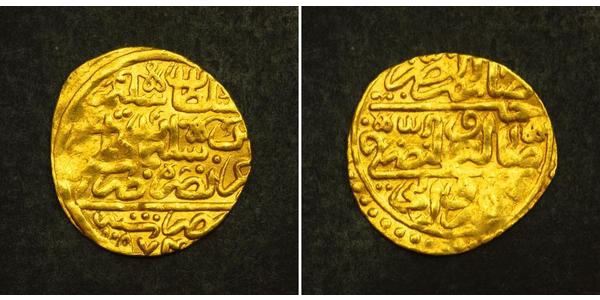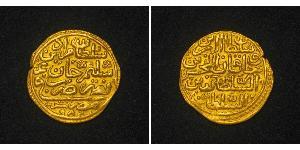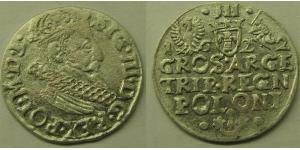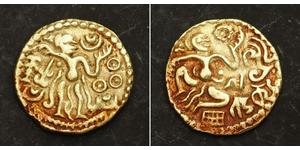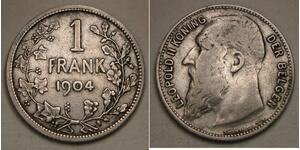(продана за $202.0)
1566, Egypt, Ottoman Empire, Sultan Selim II. Early Gold Altin Coin. 3.44gm!
Ruler (Sultan): Selim II.
Mint Place: Misr (Cairo, Egypt)
Denomination: Gold Sultani Altin
Reference: Nuri Pere 239, Friedberg 1. R!
Mint Period: 1566-1574 (struck with accession date: AH 974)
Condition: Struck on an irregular (not fully round) planchet, deformed and straightened, otherwise a nice VF+
Material: Pure Gold!
Diameter: 20mm
Weight: 3.44gm
Obverse: Legends in three lines, above mint (Misr) and accession date (974).
Reverse: Legends in four lines.
For your consideration a nice, rare and early medieval gold coin of the Ottoman Empire, struck under Sultan Murad III during 1566 AD (AH 974) at the Misr mint, which is nowadays a part of the Egyptian capital Cairo City. A scarce and early gold coin!
Selim II (Ottoman Turkish: سليم ثانى Selīm-i sānī, Turkish:II.Selim; 28 May 1524 – 12 December/15 December 1574), also known as "Selim the Sot (Mest)" in west and as "Sarı Selim" (Selim the Blond) in east, was the Sultan of the Ottoman Empire from 1566 until his death in 1574.
He was born in Constantinople a son of Suleiman the Magnificent and his legal Ukrainian wife, Hürrem Sultan.
In 1545, at Konya, he married Nurbanu Sultan whose background is disputed. It is said that she was originally named Cecelia Venier Baffo, or Rachel, (or Kale Katenou). She was the mother of Murad III . She later became the first Valide Sultan who acted as co-regent with the sultan in the Sultanate of Women.
After gaining the throne after palace intrigue and fraternal dispute, he succeeded as Sultan on 7 September 1566, According to one source Selim II became the first Sultan devoid of active military interest and willing to abandon power to his ministers, provided he was left free to pursue his orgies and debauches. His Grand Vizier, Mehmed Sokollu, from what is now Bosnia and Herzegovina, controlled much of state affairs, and two years after Selim's accession succeeded in concluding at Constantinople an honourable treaty (17 February 1568) with the Habsburg Holy Roman Emperor, Maximilian II, whereby the Emperor agreed to pay an annual "present" of 30,000 ducats and essentially granted the Ottomans authority in Moldavia and Walachia.
Against Russia Selim was less fortunate, and the first encounter between the Ottoman Empire and her future northern rival gave presage of disaster to come. A plan had been prepared in Constantinople for uniting the Volga and Don by a canal, and in the summer of 1569 a large force of Janissaries and cavalry were sent to lay siege to Astrakhan and begin the canal works, while an Ottoman fleet besieged Azov. But a sortie of the garrison of Astrakhan drove back the besiegers; a Russian relief army of 15,000 attacked and scattered the workmen and the Tatar force sent for their protection; and finally, the Ottoman fleet was destroyed by a storm. Early in 1570 the ambassadors of Ivan IV of Russia concluded at Constantinople a treaty which restored friendly relations between the Sultan and the Tsar.
Expeditions in the Hejaz and Yemen were more successful, but the conquest of Cyprus in 1571, which provided Selim with his favourite vintage, led to the calamitous naval defeat against Spain and Italian states in the Battle of Lepanto in the same year, freeing the Mediterranean Sea from corsairs.
The Empire's shattered fleets were soon restored (in just six months; it consisted of about 150 galleys and 8 galleasses) and the Ottomans maintained control of the Mediterranean (1573). In August 1574, months before Selim's death, the Ottomans regained control of Tunisia from Spain who had controlled it since 1572.

|
Добавил:
anonymous 2016-04-29 |
1 Франк Бельгия Серебро Леопольд II (1835 - 1909)
в группе 15 монет / 14 цен
⇑

